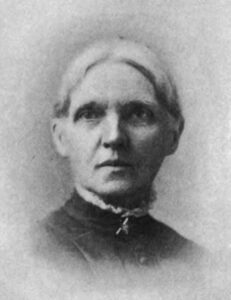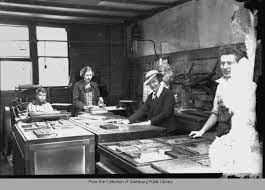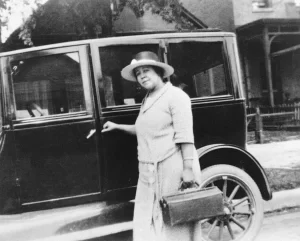
As March comes to a close, we would be remiss to not highlight some notable women in Galesburg’s history to celebrate Women’s History Month. The holiday, established in 1987, seeks to honor women from all walks of life, celebrating their achievements and accomplishments. Galesburg has had its fair share of impressive women, and here we will highlight just a few of the educators, writers, and activists who have called Galesburg home.

Julia Fletcher Carney was a writer, primary school educator, feminist, Universalist, and Boston-area resident. She achieved world fame for her poem “Little Things,” written in 1845. Born in Lancaster, Massachusetts, and educated at Lancaster Academy, she became a teacher at the age of 21. In 1849, she married Universalist minister Thomas J. Carney, and the couple had nine children, four of whom died in infancy.
Julia wrote many articles and poems for the religious periodicals of her day. She also wrote a series of Sabbath-school instruction books which were used for many years in the liberal churches. A number of her verses were also set to music and used in worship services. Julie lived on Berrien Street. Carl Sandburg remembered her as an old, little woman with snow-white hair, sitting in a rocking chair on the front porch. Sandburg recalled, “She was just one more nice old woman who wouldn’t bother boys at play” (Prairie-Town Boys, 1953). Julia’s father was a Galesburg Universalist minister. One of her sons was mayor of Galesburg from 1899 to 1901 and was the senior partner of the law firm Carney, Carney and Frank.

Mary Allensworth Creighton wrote for William Randolph Hearst’s New York American newspaper and in 1928 co-founded the Galesburg Post newspaper, which brought a new dimension to the political scene in Galesburg. The Galesburg Post supported independent candidates and causes and was involved in the reform movement that targeted the Republican machine which had controlled Galesburg.
Creighton founded the Children’s Milk Fund when milk was considered a luxury item and not given to children (only to babies). She paid for milk for 15 families in need and when she saw how the health of the children in these families had improved, she convinced her readers to contribute as well. She and a volunteer ran the Milk Fund so that all money could go towards purchasing milk. She expanded this by also purchasing infant formula from Milk Fund donations. When the government red tape prevented some from finding lodging, Creighton stepped in and helped. She heard of a family of six with a sick baby who were living in a hen house after World War II. She found them housing. Post readers donated furniture and local carpenters donated time to make the house livable. She helped other families in need of homes. The Milk Fund helped pay utility bills, provided used washing machines, refrigerators, shoes, and boots. She never said no to anyone needing help. She was named Woman of the Year by the Cosmopolitan Club and awarded the Charles Morrow Memorial Award for outstanding contribution to journalism. She was also active in the restoration of Knox College’s Old Main building.

Justina Ford was the first African-American woman physician in the Denver, Colorado area. Before that, she was born in Knoxville and grew up in Galesburg. Her mother was a nurse, and she was the seventh child in the family. She would not play with her siblings unless they played hospital and she was the doctor.
Following her graduation in 1899 from the Hering Medical School in Chicago, she directed a hospital in Normal, Alabama for two years. Then she moved to Denver in 1902. She applied for a license and found the authorities were reluctant to grant it to her because she was an African-American woman. However, she did eventually get her license and set up her practice. Still, the medical community was slow to recognize her abilities.
Specializing in obstetrics, gynecology, and pediatrics, she became known as the “baby doctor.” Because Denver General Hospital would not take Black patients or physicians, Ford took her practice door-to-door. A stern and brisk-mannered woman, Ford was known for her unique system of delivering and providing the best care for mother and baby in home. She delivered more than 7,000 babies to patients from many ethnic groups.

Ella Park Lawrence is considered to be the mother of the Illinois State Flag and helped found the Galesburg Chapter of the Daughters of the American Revolution. At the time, there was no Illinois Flag so she started a letter writing campaign with her chapter and convinced other chapters in the state to write letters to state politicians. She visited state officials and members of the General Assembly in Springfield and offered a prize of $25 for the winning design for a state flag. The state flag became official on July 6, 1915. She personally paid to have the first five flags painted on silk with gold fringe borders and mailed two of them to Illinois Secretary of State and Governor Edward Deneen. She also provided $1,400 of her own money to start construction of the Free Kindergarten, today known as the Harrington Home.
Those are just a few of the extraordinary women in Galesburg’s history who deserve to be celebrated — there are countless more. Do you know an Extraordinary Woman? Consider joining the library in the 100 Extraordinary Women initiative, a fundraising opportunity to help build the Skills Lab in the new library building. More information can be found in this post.
Information on the women in this column came from the 2012 “Notable Women of Galesburg, Illinois” project.

